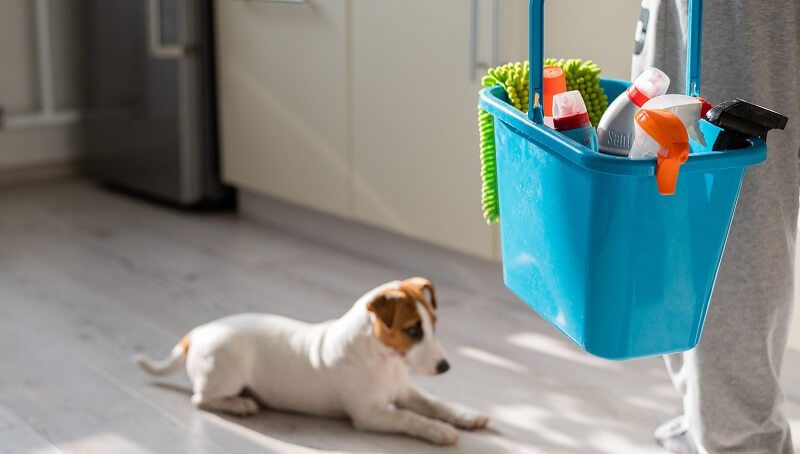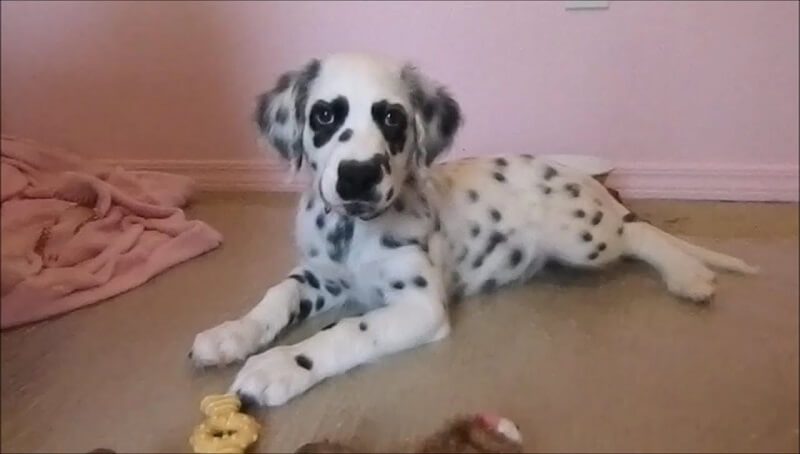Several products used around the house and in the house for disinfection and cleaning are extremely toxic to pets. Most cleaning products, as well as the disinfecting agents that are used to wash the streets, contain chemicals dangerous to pets. If your dog ingested any of these products, toxicity could lead to serious complications in the digestive and respiratory systems. Chlorine poisoning or other cleaning substances with bleach are considered veterinary emergencies.
Therefore, if you go for a walk with your dog outside the house, you will need to wash his paws thoroughly when you return home. If your pet has been frequently exposed to chlorine-cleaned surfaces, it is advisable to bathe it with special pet shampoos. We should also do this to the surfaces to which the dog has access to rinse them thoroughly with clean water after disinfection with chlorine. If your dog has inhaled the vapor of chlorine-based substances, it may have symptoms such as cough, and lung irritation, as well as persistent panting. There may also be eye symptoms such as conjunctivitis or corneal damage.
Toxic substances for dogs
There are various types of household products that are dangerous for dogs:
- Chlorine or chloramine, the main component of bleach
- Disinfectants for the toilet
- Dish detergent
- Laundry detergent
- Soda
- Gasoline
- Acetone
- Acidic products containing hydrochloric acid, sulfuric acid, chlorine, bromine, and iodine.
- Alkaline products (sodium or potassium hydroxide, ammonium hydroxide, and potassium permanganate)
- Substances used for cleaning sewer installations
- Shampoos
- Soap
- Laundry conditioners
- Water softeners
- Diluents and paint
Symptoms of bleach poisoning in dogs
In the case of intoxication, the signs may appear immediately or within a few hours of ingestion. The symptoms are varied and depend on both the substance and the amount the dog has ingested. Among the most popular ones are:
- Cough and sneeze
- Dyspnea
- Lethargy/weakness
- Abdominal pain
- Nausea/vomiting
- Hypersalivation
- Tremors and muscle stiffness
- Agitation
- Ulceration in the paw pads or in the mouth
- Eye injuries
- Dilated pupils
- Discoloration of the paw
- Diarrhea
- Convulsions
- Collapse
- Coma
- Fever
- Blood loss (blood in the stool, nasal bleeding, anemia)
- Cardiac disorders
- Apathy
- Ataxia – difficulty coordinating limbs due to neurological problems
- Excessive thirst
- Frequent urination
- Loss of appetite
- Gastric irritation
- Skin rashes and irritations
Complications of chlorine poisoning and chlorine-derived substances in dogs
Chlorine poisoning can cause aspiration pneumonia, changes in blood serum, kidney damage, blood clotting abnormalities, and other serious health problems including gastrointestinal disorders. Severe cases of chlorine poisoning are medical emergencies and should be treated urgently.
Diagnosis of bleach intoxication in dogs
 Call your veterinarian if you see any of the signs listed above to schedule an emergency visit.
Call your veterinarian if you see any of the signs listed above to schedule an emergency visit.
Try to find out what is the cause of the poisoning. Check which substances your dog has access to and check if the packaging is intact. If your dog has been burned around the mouth, it will take a few hours before the signs are visible. Your veterinarian may examine his mouth to see if there is any sensitivity when touching it. The stomach and esophagus may suffer burns because of the substance the dog has been intoxicated with. This will not be visible until the internal examination.
Treatment of bleach poisoning or other corrosive substances in dogs
If you do not go to the veterinarian
If you don’t have a veterinarian close by or the veterinarian’s office is closed, talk by phone with the attending veterinarian and explain all the symptoms, how long it has passed since the event, as well as information about the dog: breed, age, gender, weight, whether he has other health problems, etc.
You might also like my articles on chocolate, cafeine, or sodium poisoning in dogs.
If your dog has been intoxicated with bleach, a soda-based cleaning product, or any other chlorine derivative, an oil product, do not try to cause vomiting at home. It is also not recommended to do this if the dog is unconscious, if more than two hours have elapsed since ingestion, or if the dog has seizures. For these cases, you should go to the veterinarian immediately.
You can induce vomiting at home, under the guidance of your veterinarian, only if you are sure that the substance your dog has ingested is not corrosive, that it has not been more than two hours since ingestion and your dog is conscious.
You can administer warm, very salty water orally, 1-5 ml/kg bodyweight with a syringe through the corner of your dog’s mouth. If you have hydrogen peroxide or activated charcoal in your home, your veterinarian will explain how to use it and in what doses it should be used to cause vomiting to your dog.
If the paws are very irritated, after washing them with warm water, you can gently wash them with milk, which is indicated in the dilution for drinking if the dog shows mild digestive symptoms. Milk can reduce the corrosive effect of ingested substances in the lining of the esophagus and stomach.
In addition, you can carefully clean his eyes with physiological serum.
If you go to the veterinarian
If you manage to get to your veterinarian quickly, he or she will try to treat your dog safely. If you have given your dog any medicine, take it with you and show it to your veterinarian. If you have found the bleach or the substance your dog has been intoxicated with, take the pack with you so that your veterinarian can diagnose and provide treatment based on the substance your dog has been intoxicated with.
If your dog shows serious signs of intoxication, your veterinarian may perform gastric washes. Your veterinarian will also use activated charcoal or oxygenated water to cause vomiting. If the dog has symptoms in the fur or paws, he will be washed and after emergency therapy, he will receive treatment with fluids and special medications for ulcers and supportive care for any other symptoms. Even though it may seem like a simple solution, your veterinarian may also give your dog milk to dilute the ingested substances and reduce their corrosive effects.
Recovery from poisoning with bleach or other cleaning substances
After treatment, the dog will be monitored for several hours before being discharged. This will allow your veterinarian to make sure that there are no other complications, no vomiting, or life-threatening burns to the mucous membranes. Your veterinarian will recommend a special diet after discharge and you will need to be careful when storing cleaning substances inside the house, in places where the dog will not have access, or when you are using them.
Final thoughts!
A lot of people are using chlorine-based products around the house for cleaning purposes, and the easiest way to protect your dogs is to pay attention to where you store them. If you wash the house with chlorine-based substances, like bleach, or caustic soda, close your dog in a room where you do not plan to clean the floor. Leave the substance to do its job for half an hour, then rinse the floor with clean water. You can then allow the dog to access this area and you can clean the room you have kept him in during this period.




